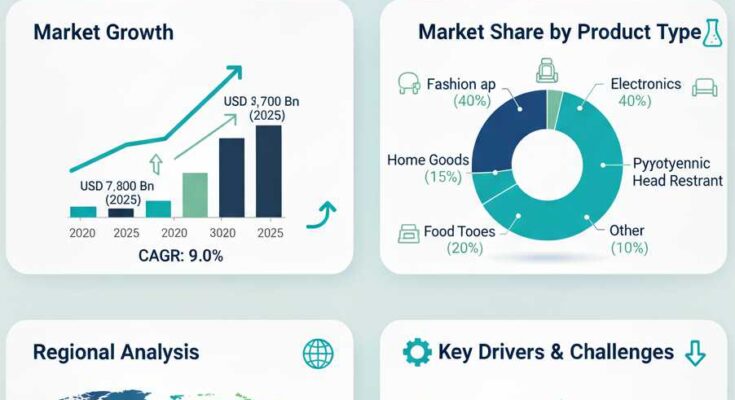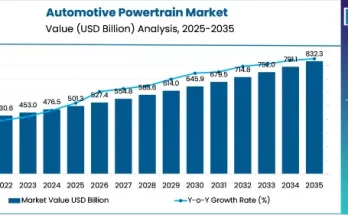The global automotive whiplash protection system (WPS) market is projected to expand from USD 3.10 billion in 2025 to USD 6.39 billion by 2035, achieving a CAGR of 7.5% over the forecast period, according to Fact.MR. Increasing awareness of vehicle safety, stringent government regulations, and rising passenger vehicle demand are driving the market, while innovations in intelligent seating and reactive head restraint (RHR) technologies are shaping the next generation of occupant protection.
Market Overview
-
Market Size (2020): USD 2,424 million
-
Market Size (2025E): USD 3,100 million
-
Market Size (2035F): USD 6,390 million
-
Historical CAGR (2020–2024): 4.8%
-
Forecast CAGR (2025–2035): 7.5%
-
Key Technologies: Reactive Head Restraints (RHR), Pendulum Systems, Spring-Activated, Pyrotechnic Head Restraints, Pro-Active Head Restraints
-
Leading Vehicle Segment: Passenger Vehicles
-
Primary Sales Channels: OEM, Aftermarket
Whiplash protection systems are engineered to reduce neck and spine injuries during rear-end collisions. They include reactive headrests, energy-absorbing seatbacks, and intelligent seat systems designed to activate instantaneously during impact.
Market Drivers
-
Stringent Safety Regulations: Governments worldwide, particularly in North America, Europe, and Asia, are mandating advanced occupant protection systems in vehicles, including WPS.
-
Rising Consumer Awareness: Growing concern over traffic accidents and increased adoption of passenger vehicles with safety systems are accelerating market growth.
-
Technological Advancements: Integration of AI, machine learning, and sensor-based head restraints allows real-time adjustment to collision forces, enhancing effectiveness.
-
Expansion in Emerging Economies: Rising disposable income and expanding automotive sectors in China, India, and Southeast Asia are driving adoption of advanced safety systems.
-
Premium & EV Market Growth: Consumers increasingly expect intelligent safety features in premium, electric, and autonomous vehicles, creating opportunities for innovative WPS solutions.
Market Restraints
-
Cost sensitivity in developing markets slows adoption of advanced safety systems.
-
Regulatory differences across regions can delay uniform implementation of WPS.
-
Supply chain and manufacturing challenges, especially in sourcing advanced seat components, may constrain growth.
Regional Insights
-
North America: The U.S. leads with stringent safety standards enforced by the National Highway Traffic Safety Administration (NHTSA). OEMs integrate RHR and energy-absorbing seatbacks across mid-to-premium vehicles. CAGR 6.6% (2025–2035), Market Value 2035: USD 1,184 Mn.
-
Europe: Regulatory compliance with Euro NCAP ratings and high OEM adoption of advanced seat systems drive demand, especially in Germany, France, and the UK.
-
Asia-Pacific: Rapid automotive growth in China and India, rising consumer awareness, and government safety initiatives fuel market expansion. China’s market expected to reach USD 787.5 Mn by 2035, CAGR 6.8%, while India’s market projected at USD 552.5 Mn, CAGR 7.3%.
-
Latin America & Middle East/Africa: Emerging markets show potential as improving economic conditions and rising vehicle sales encourage WPS adoption.
Segmental Analysis
By System Type:
-
Reactive Head Restraints (RHR): Lead the market due to passive operation, spring-loaded or motorized actuation, and integration with existing seat safety components. They provide automatic protection in rear-end collisions, reducing cervical spine injuries.
-
Pendulum, Spring-Activated, Pyrotechnic, and Pro-Active Head Restraints: Offer varied levels of protection and are often found in premium or high-performance vehicles.
By Vehicle Type:
-
Passenger Vehicles: Largest market share due to safety regulations and consumer demand for sedans, SUVs, and hatchbacks.
-
Commercial Vehicles: Growth driven by fleet safety mandates and operator liability concerns.
By Sales Channel:
-
OEMs: Dominate due to integration of WPS in new vehicles meeting compliance standards.
-
Aftermarket: Growing segment driven by retrofits and replacements in aging fleets.
Country-Specific Insights
-
United States: Integration of AI-driven, real-time adaptive RHR systems strengthens market growth. Premium vehicle adoption and sustainability-focused manufacturing (e.g., 3D printing seat components) further enhance demand.
-
China: Rapid automotive growth, government safety regulations, and focus on autonomous/EV vehicles stimulate WPS adoption. AI-enabled, recyclable seat components align with sustainability goals.
-
India: Early-stage market with rising urban vehicle sales. Strengthening government safety regulations and increased adoption in mid-range and luxury vehicles expected to accelerate growth.
Competitive Landscape
The automotive WPS market is highly competitive, with leading players investing in R&D and strategic partnerships. Key companies include:
-
Autoliv Inc.: Leader in reactive head restraints, airbags, and energy-absorbing seat systems; invests heavily in global OEM partnerships.
-
TAKATA Corporation (now part of Key Safety Systems): Offers RHR systems, airbags, and occupant safety technologies; focuses on passive safety innovation.
-
Robert Bosch GmbH: Develops AI-driven, sensor-integrated headrests and advanced seat safety systems.
-
Delphi Automotive Plc: Provides advanced head restraints, seat systems, and global safety collaborations.
-
ZF Friedrichshafen AG: Offers adaptive seat systems and whiplash protection solutions for premium and commercial vehicles.
-
Continental AG: Active and passive headrest systems; invests in vehicle safety and sustainable mobility solutions.
-
GRAMMER AG, Lear Corporation, Hyundai Mobis Co. Ltd., Ningbo Joyson Electronic Corp.: Provide innovative seating and safety solutions for passenger and commercial vehicles.
Market Share Highlights:
-
Top 5 Players: ~52–63%
-
Tier II Players: ~16–25%
-
Other Players: ~45–55%
Recent Innovations & Trends
-
AI-driven adaptive headrests that react to occupant posture and collision dynamics.
-
Energy-absorbing materials and adjustable headrest mechanisms for optimized injury mitigation.
-
Integration with autonomous vehicle safety systems.
-
Use of recyclable materials and 3D-printed components to improve sustainability and reduce carbon footprint.
Market Outlook (2025–2035)
The Automotive Whiplash Protection System Market is poised for sustained growth, fueled by regulatory mandates, consumer safety awareness, and technological innovations. Integration of AI, intelligent seating systems, and advanced materials will redefine occupant protection in passenger and commercial vehicles. Emerging markets in Asia-Pacific and Latin America are expected to drive future expansion, while global OEMs continue to prioritize WPS in both conventional and electric/autonomous vehicles.
Browse Full Report : https://www.factmr.com/report/301/automotive-whiplash-protection-system-market
Segmentation Summary
-
System Type: Reactive Head Restraints, Pendulum, Spring-Activated, Pyrotechnic, Pro-Active Head Restraints
-
Vehicle Type: Passenger Vehicles, Commercial Vehicles
-
Sales Channel: OEM, Aftermarket
-
Region: North America, Latin America, Western Europe, Eastern Europe, East Asia, South Asia & Pacific, Middle East & Africa
Fact.MR’s report offers comprehensive insights into market size, growth trends, technological innovations, regional dynamics, and competitive landscape, enabling stakeholders to make informed strategic decisions in the automotive whiplash protection system market.



